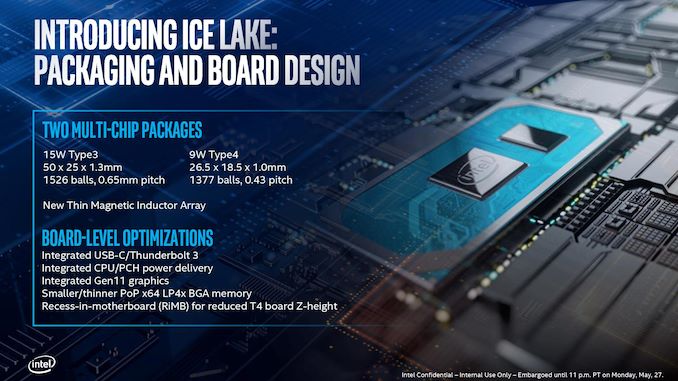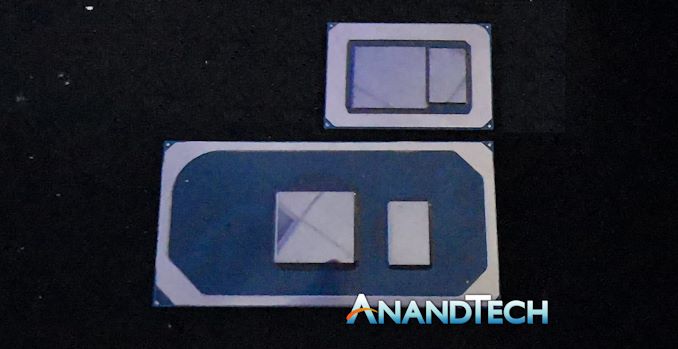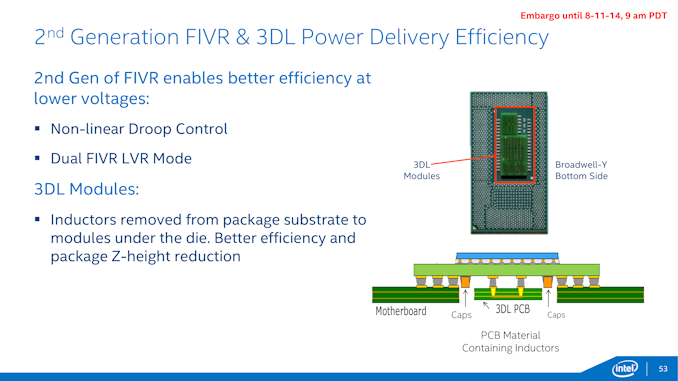Examining Intel's Ice Lake Processors: Taking a Bite of the Sunny Cove Microarchitecture
by Dr. Ian Cutress on July 30, 2019 9:30 AM EST- Posted in
- CPUs
- Intel
- 10nm
- Microarchitecture
- Ice Lake
- Project Athena
- Sunny Cove
- Gen11
Two Versions, Two Different Power Targets
Intel has promised that Ice Lake-U will be seen in a variety of form factors, targeting anywhere from 9W to 28W. This sort of range is not new for a U-series processor – we typically see overlap from something lower down (the Y-series, ~5W) or higher up (H-series, ~45W), however Ice Lake hasn’t currently been listed for H series power budgets - only Y and U. Having such a wide window, from 5-28W, allows Intel to be very wide with binning the chips as they come of the production line, which is a very valid tactic for promoting as much yield as possible with minimal waste.
Technically there will be two different Ice Lake BGA mobile packages – one aimed at low power (7-12W) for the Y series, and another for higher power designs (15-28W) in the U series.
At this point Intel has not stated what core configurations will be in both packages, however it is likely that the lower power 7-12W ‘Type 4’ package will be for Y-series implementations only, especially given that the overall package size is only 490mm2 (26.5x18.5) compared to 1250 mm2 (50x25), making it 39% the size of the larger high power package. It stands to reason then that the smaller package is for lower performance and low power options, despite being exactly the same silicon.
This Type-4 option also uses the ‘recessed in board’ design we first saw with Broadwell-Y, which is required based on the integrated voltage regulators that Intel now uses on its low powered designs. This makes a very interesting point about Intel’s capabilities with low powered 10nm designs: one could postulate that as the recessed model is well above the traditional Y-series power line. If the 10nm process doesn’t go low down enough in power to that sub-5W range, it could either be because of power, or there isn't enough frequency for Intel to actually sell at volume. Alternatively Intel could end up increasing the base power of the Y-series. One could draw parallels with the first generation 10nm Cannon Lake Core i3-8121U at 15W, which was initially postulated to be dual-core Y-series silicon, rather than the 15W U-series designation it ended up with (our review showed that it did indeed consume more power for the same work compared to a 14nm equivalent design, which would imply a very high static power). With this in mind, it makes me wonder what percentage of Type 3 / Type 4 package designs Intel will end up shipping into the market.
Broadwell Motherboard Design for Recessed Power Implementation
Intel is keen to promote that one of the new features of Ice Lake is its Thin Magnetic Inductor Array, which helps the FIVR achieve better power conversion efficiencies and waste less power. The main issue with a FIVR is at low power consumption states that have a lot of inefficiency – some other processor designs have a linear LDO (Low-Dropout Regulator) implementation which is better for low power designs but less efficient in high power modes.













107 Comments
View All Comments
PeachNCream - Tuesday, July 30, 2019 - link
Are there really that many eGPUs out there though?HStewart - Tuesday, July 30, 2019 - link
Just do a search on amazon for eGPU and you find 3 pages full of then. ASUS, Gigibyte, and Dell are examples plus many 3rd party.PeachNCream - Tuesday, July 30, 2019 - link
Not for sale. Actually in use by people.The_Assimilator - Wednesday, July 31, 2019 - link
2.Retycint - Wednesday, July 31, 2019 - link
One of the reasons that eGPU adoption rates are low is precisely because of the limitation mentioned above - huge performance drop (anywhere from 30-50% I think) compared to PCI-E connection, due to bandwidth limitations.DanNeely - Wednesday, July 31, 2019 - link
The performance issue is TB3 overhead. Running a GPU on an internal PCIe3 x4 link will come within a few percent of an x16.repoman27 - Tuesday, July 30, 2019 - link
"There is still some communication back and forth with the chipset (PCH), as the Type-C ports need to have USB modes implemented."Just to add to that, all of the high-speed signaling (Thunderbolt, DisplayPort, SuperSpeed USB) is handled by the CPU die, and the PCH only transacts in USB 2.0 and the low-speed, out-of-band management channel for Thunderbolt (LSx).
I fully understand why you (Ian) included the asterisk, because many OEMs won't bother implementing Thunderbolt 3 due to the additional expense / complexity, but to be fair to Intel, they integrated Thunderbolt as much as they possibly could. It's really not feasible to include all of the power and analog signal conditioning necessary for Thunderbolt 3 on the CPU package.
Galatian - Tuesday, July 30, 2019 - link
The numbers of the iGPU don’t really add up. They are comparing their best new GPU to last Gens UHD 420. I don't see the performance gain.at8750 - Tuesday, July 30, 2019 - link
Probably,CML-U
i7-10510U 4C 1.8GHz TB:4.9/4.8/4.3GHz
i5-10210U 4C 1.6GHz TB:4.2/4.1/3.9GHz
ICL-U
i7-1065G7 4C 1.3GHz TB:3.9/3.8/3.5GHz
i5-1034G1 4C 0.8GHz TB:3.6/3.6/3.3GHz
digitalgriffin - Tuesday, July 30, 2019 - link
Ian,You do know pure Silicon is highly toxic? I wouldn't even hang it in your house unless it was plated in a clear lacquer. It degrades when exposed to open air. And it's been shown to cause cancer. I know you wouldn't actually bite it. But be sure to wash your hands.